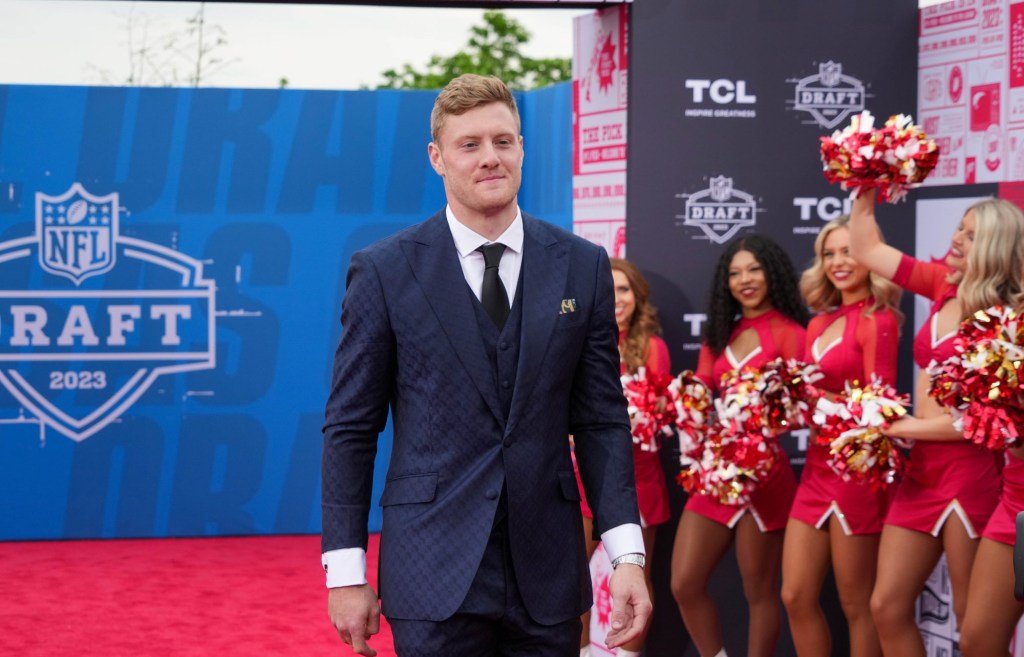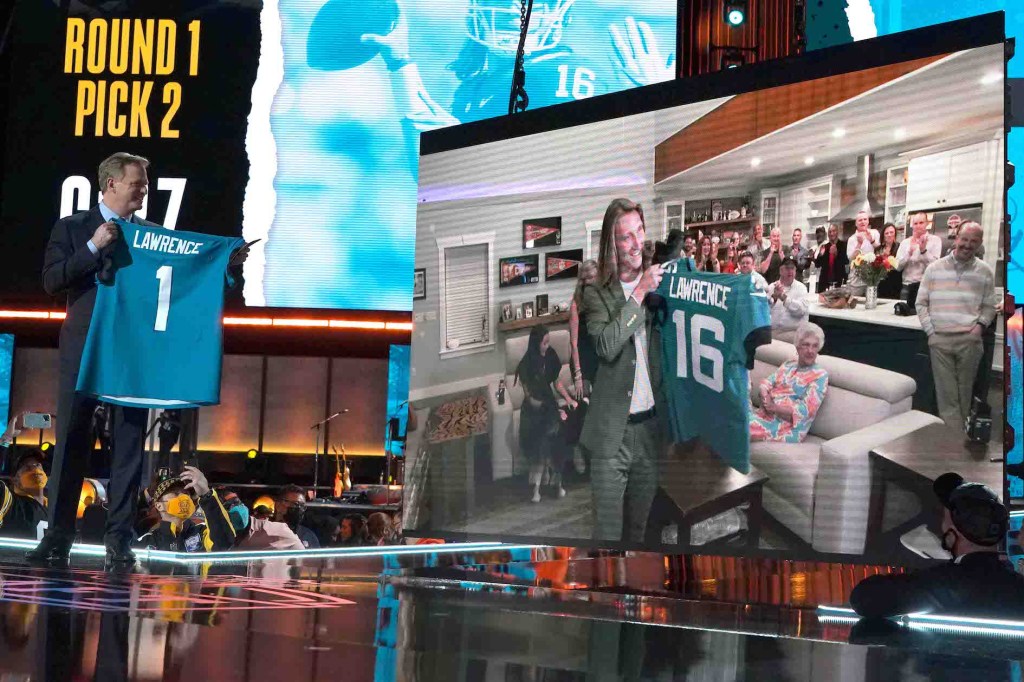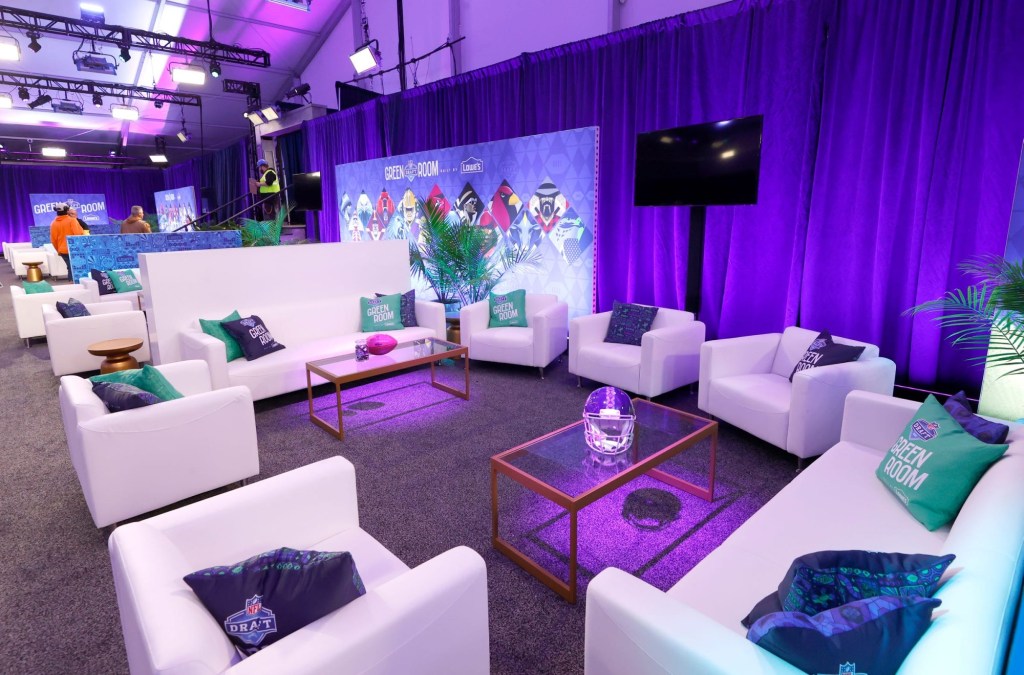In a rubber-necking TV moment when viewers couldn’t look away, a stunned Will Levis, flanked by his mother, sister, and girlfriend, sat on a green room couch as he free-fell through the first round of the 2023 NFL draft.
Once projected as a possible top-five pick, the Kentucky quarterback, in a matter of hours, went from bright-eyed and bushy-tailed to bolting host site Kansas City when he was not selected during the first night. When Levis (below) finally got the call that the Titans were taking him in the second round, he cried with relief back home in Connecticut. It was more than public humiliation: His precipitous fall may have cost him as much as $25 million.
“It’s one of those things where you feel like you’re going to handle yourself and be composed, but then the waterworks started flowing,” the QB said at the time.
He’s not alone. The last few decades have seen many projected high first-rounders, after months of prediction and prognostication by draftniks, take nosedives on the biggest stage and, in real time, lose millions in salary and signing bonuses. Think epic draft falls such as Drew Lock (2019), Laremy Tunsil (’16), Johnny Manziel (’14), Geno Smith (’13), Brady Quinn (’07), and four-time MVP Aaron Rodgers (’05).
Of course, a fresh-faced prospect’s cruel slide can make for riveting reality TV. It’s Survivor’s tribal council meets The Bachelor’s rose ceremony. But it’s no joke to sweating players and their nervous agents. Thursday night’s opening round was watched by an average of 12.1 million people in prime time across ESPN, ABC, and NFL Network. That’s more than the viewership for last year’s World Series and Stanley Cup Final—and just behind the NBA Finals.
Styling and profiling in the green room can help prospects land corporate sponsors. But for those who don’t hear their names called, it can be the longest night of their lives. There’s nowhere to hide from the TV cameras. Their agonizing wait is beamed live. Ditto for anxious family and friends with them in the green room.

In recent years, the NFL has tried to emphasize the celebratory side of its biggest offseason event. But today’s media-savvy college stars know the risks of donning a flashy suit, traveling to the draft, and watching the first round play out. Unless they’re virtually guaranteed to go in the top 10, why take the chance of being the last man standing when the music stops? Better to stay home than become a cautionary tale.
Even highly touted Michigan QB J.J. McCarthy, for example, who was drafted at No. 10 by the Vikings, declined the league’s invite this year. The falling number of green room invitees has more to do with prospects’ wishes than the league’s, according to Charlie Yook, executive producer of NFL Media.
“I don’t think it’s a de-emphasis on our end. But it may be a de-emphasis on the players’ end. That’s up to the player themselves,” Yook tells Front Office Sports.
If prospects don’t know the deal, agents educate them. If clients ask for his advice, agent Brad Blank tells them to skip the draft and watch from home. Avoid catering expensive draft parties, too, he says. They can turn from celebratory to sour in a heartbeat.
“I think it’s healthier for everybody’s mental sanity to watch the draft in a private place. Because you’re at the draft doesn’t mean you’re going to go any higher,” Blank tells FOS.
Just one decade ago in 2014, a record 30 players were invited to attend the draft in person at New York’s Radio City Music Hall. This year, the NFL invited only 13 players to Detroit. Welcome to the era of the shrinking green room.
In 2016, Tunsil found himself in the football version of a Greek tragedy. Before the draft in Chicago, the Ole Miss left tackle was touted as a possible No. 1 overall pick. But just before draft night, a vengeful hacker posted an embarrassing video of him smoking marijuana with a bong and gas mask. A shaken Tunsil slid down to the Dolphins at No. 13. With the world laughing at him on live TV, Tunsil somehow put on a brave face. But inside he was completely “f***ed up,” he told Complex.
As one of the best tackles in the NFL, Tunsil has earned $121.1 million over his eight-year career. But the four-time Pro Bowler, still on a mission to recoup the lost millions from the infamous bong video, negotiated a $75 million extension by himself with the Texans in 2023.
As Tunsil told Complex: “To this day, I still play with the anger, because I have to prove myself, because I feel like I’m not getting the accolades I deserve because of the gas mask.”

And players’ reactions to heartbreak in the green room can impact their NFL careers. Smith’s pouting reaction to being ignored in the first round of the 2013 draft unfairly painted the West Virginia QB as a malcontent. Four teams into his 10-year career, the journeyman has finally come into his own as starting QB of the Seahawks.
Agents have their own mechanisms to protect clients. Consider Boston College guard Chris Lindstrom, selected 14th by the Falcons in 2019. Blank agreed to let ESPN’s cameras into his client’s home on draft night—under the proviso they didn’t start filming until after Lindstrom knew which team was taking him.
Recalls Blank: “Then the floodgates opened and all the friends and relatives came over. And they had a nice party. But there was no pressure on him while it was happening.”
Alas, players don’t always listen. Blank had one client, whom he declined to name, who didn’t want to attend the draft. Things did not go smoothly, but the player was pressured into it by his family, who wanted their day in the TV spotlight. “They were like, ‘This is our moment. We have suits picked out and dresses. This is what we’ve all been working for.’”
It’s not all snubs and slides.
Since 2019, ESPN and ABC have offered their own distinct coverage of the NFL’s traveling, three-day draft circus. ESPN is more X’s and O’s; ABC takes a more College GameDay–centric approach. That enabled Seth Markman, who’s executive producing ESPN-ABC’s draft coverage, and his team to experiment. While Molly McGrath interviews prospects after they’re selected on ESPN, Laura Rutledge interviews their loved ones on ABC, for example.
“Honestly, that’s created some of the great moments from the last five years,” Markman says. “The pride they have in their son getting drafted. You can’t help but feel that when you’re watching. You feel the emotions; you get choked up. I love that aspect of it.”
Still, many of today’s college stars don’t see the difference between appearing on national TV from the site of the draft and their own living room, points out Yook, who leads NFL Network’s draft coverage.
“The landscape of college football has changed dramatically in the past couple of years. I think generationally, perhaps a time ago, there was a desire to be at the venue to get your moment onstage. But … I don’t know if kids this age right now think that’s important,” says Yook. “We feel that’s important, right? That moment onstage, in front of the fans and a national TV audience, giving the commissioner the handshake, the hugs. But I can’t speak for these individuals who may be like, You know what? Being home is more important. Being with my family is more important.”

Plus, remote cameras give top draft picks an easy option to skip the draft. No. 1 pick Trevor Lawrence didn’t attend the 2021 draft in Cleveland. Instead, he staged his own party near Clemson. The NFL’s all-virtual draft coverage in ’20—which went off without a hitch in the teeth of the COVID-19 pandemic—accelerated the remote trend.
“I feel it’s a nice changeup when you see somebody celebrate in the green room and go meet the commissioner. Then the next pick is at home with 30 or 40 people jumping on him,” notes Markman. “I don’t think it’s a big deal either way. Thirty [invites] feels like too many to me, when we were at that point. I think we’re at a better number now, more controllable.
“Ultimately, the goal, too, is not to embarrass kids. Not to bring in so many people that you wake up on Friday and you say, O.K., we had six kids who sat there all night in the green room and didn’t get picked. That’s not a great look, either.”
Levis might beg to differ, but ESPN says it has shifted away from its reality show–like coverage of the green room from a decade ago. According to Markman, ESPN is more selective, and sympathetic, when it comes to showing disappointed prospects.
“Years and years ago, that was not our approach. It was like, ‘Keep showing them,’” the ESPN vice president tells FOS. “But over the years, we’ve kind of realized there’s such a human element to this that we can be a little more conservative.”
Still, the draft’s broadcast partners will never abandon the human drama of the green room. Part of the event’s inherent TV appeal is its utter unpredictability. Markman calls it “high theater.” Yook calls it the “ultimate reality TV” show. Nowhere does reality bite harder than the green room.
Says Yook: “We’re going to continue to give out as many invites as we can. Thirteen is a number we just kind of landed on. But I don’t think we’re going to reduce our desire to have people there. It’s a lifetime moment. You’re never going to get that opportunity back.”
But even the biggest stars have ended up green around the gills after an anxious night in the green room. As Rodgers told ESPN in 2013: “Unless you’re going to be the first or second pick … I’d say, ‘Stay home.’”





